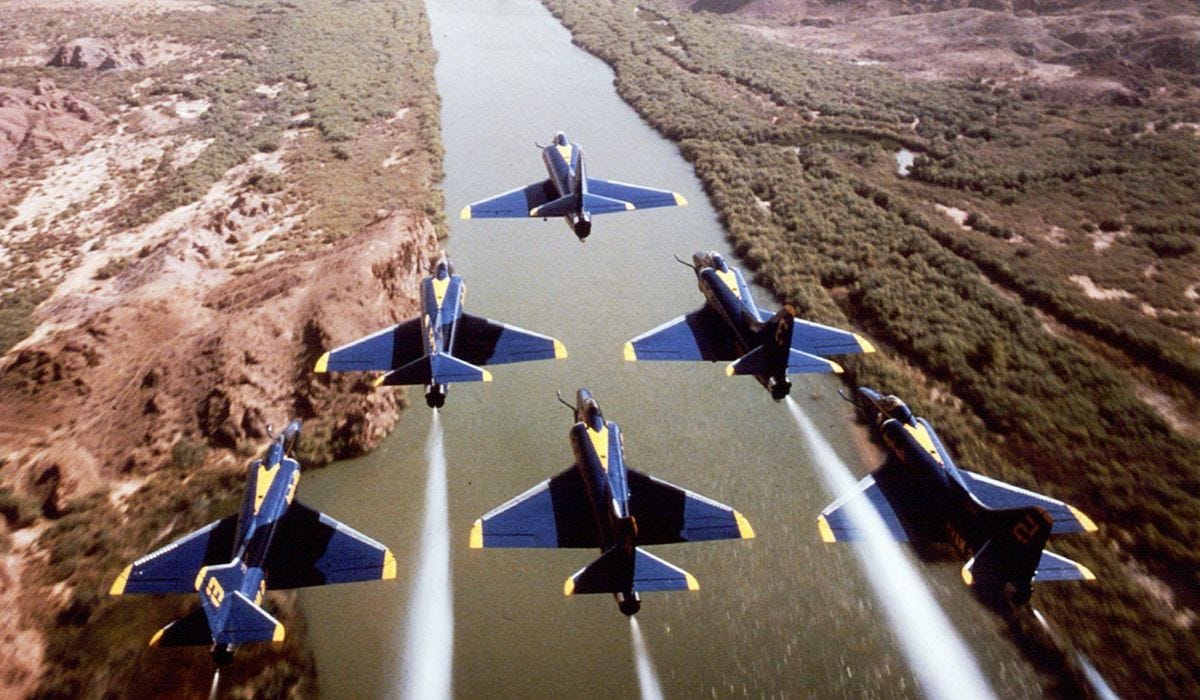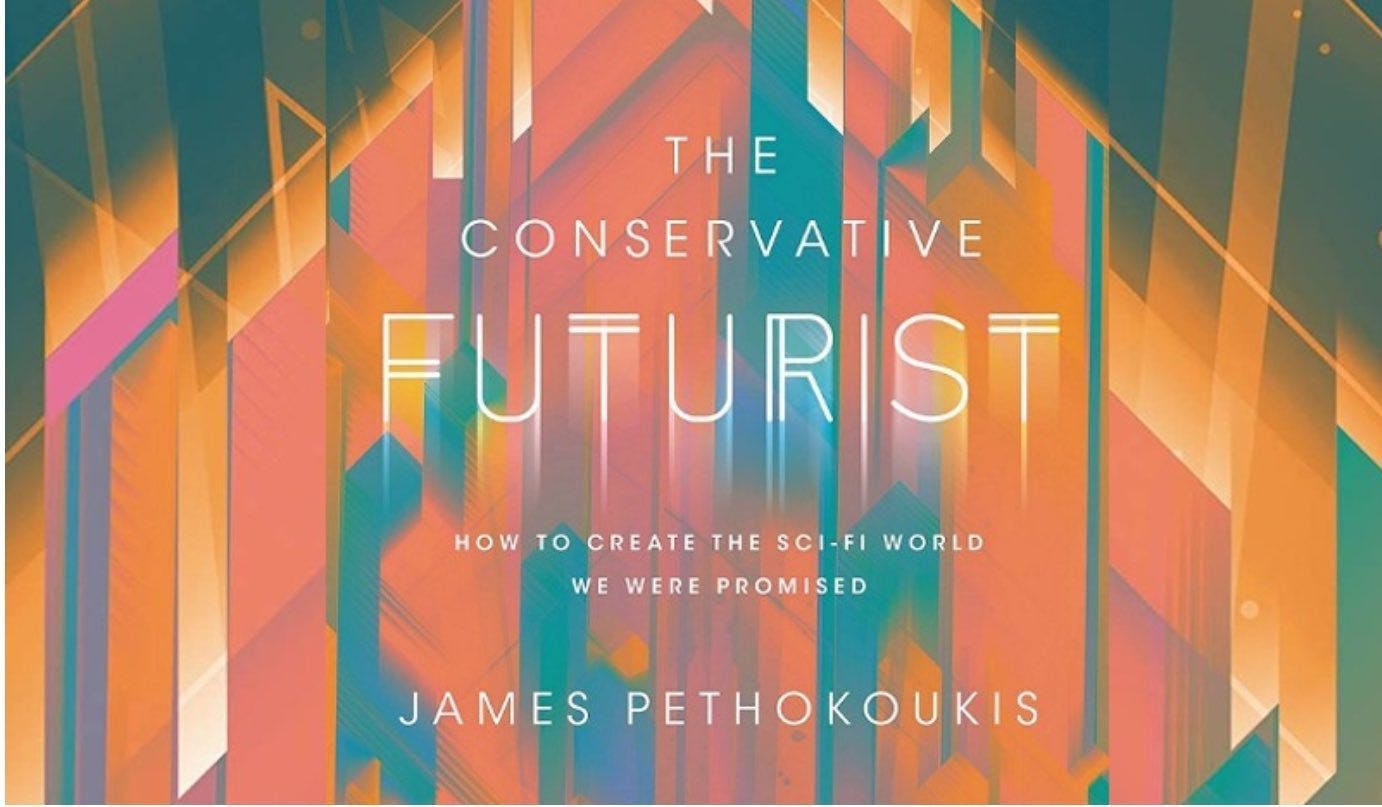⤴🎦 An Up Wing film from a Down Wing decade
'To Fly' was one of many pro-progress artifacts and advances in the 1970s
My fellow pro-growth/progress/abundance Up Wingers,
Twice in recent history, America flirted with an Up Wing future — an era defined (according to me, at least) by audacious technological ambition and economic exuberance. Up Wing 1.0 (1955–1973) thrived on postwar confidence and a humming economy, culminating in multiple Moon landings and nuclear energy enthusiasm … before faltering amid stagflation, a collapse in productivity growth, and a cultural pessimism streaked with degrowth thinking.
So long to both the Atomic and (manned) Space Ages. A fleeting revival, Up Wing 2.0 (1995–2000), rode the internet boom, only to implode with the dot-com bust.
The two Up Wing periods bookended the 1970s, a decade drenched in Down Wing pessimism. Hollywood turned dystopian, with films like Soylent Green and Logan’s Run, while techno-pessimists supplanted techno-optimists in public discourse about the future. Environmental alarmism surged, epitomized by the backlash against nuclear energy following the Three Mile Island accident. Innovation became suspect, and progress a supposed liability. This philosophical retreat, as much as any economic shock, explains America’s stalled future, as I explain in my 2023 book, The Conservative Futurist: How To Create the Sci-Fi World We Were Promised
Of course, my demarcation of these Up Wing and Down Wing periods are generalizations. Pro-progress things happen during even the most anti-progress eras, whether the innovation boom of the 1930s or the emergence of smartphones just as the 2000s Global Financial Crisis exploded.
Or how about the 1970s? It wasn’t all economic chaos and “Limits to Growth” ideology, as dominant as those themes were. Some Up Wing stuff happened, too. Lots, actually. For example:
(1971) First commercial microprocessor. Intel's 4004 crammed an entire CPU onto a single chip, a feat that would democratize computing power and spawn an industry worth trillions.
(1971) First network email. Ray Tomlinson's elegant solution — using "@" to separate user from machine — transformed how humans communicate, though he could scarcely have imagined today's inbox deluge.
(1973) Ethernet created. Bob Metcalfe's packet-switching protocol, sketched out in a Xerox PARC memo, would become the invisible plumbing of the digital age.
(1973) Recombinant-DNA breakthrough. Herbert Boyer and Stanley Cohen's gene-splicing technique did more than mix DNA from different species — it birthed the biotechnology sector and all its promise.
(1975) Altair 8800 kit hits mail-order catalogs. This hobbyist's box of circuits prompted two young men, Bill Gates and Paul Allen, to abandon their studies and found what would become the world's most valuable company.
(1975-76) Viking landers on Mars. America's twin spacecraft achieved what had eluded the Soviets: successful soft landings on the Red Planet, proving robotic exploration could extend humanity's reach.
(1976) Concorde enters service. The Anglo-French supersonic jet shrank the Atlantic to a three-hour hop, though its commercial failure would later prove that speed isn't everything.
(1977) MRI's first full-body human scan. Raymond Damadian's ungainly contraption, dubbed "Indomitable", took five hours to peer inside a human thorax — but medicine would never be the same.
(1977) Voyager 2 and 1 launch. These nuclear-powered ambassadors continue broadcasting from the cosmic frontier nearly half a century later, monuments to American engineering prowess.
(1977) Atari 2600 arrives. With its interchangeable cartridges and microprocessor brain, this console transformed electronic entertainment from arcade curiosity to living-room staple.
(1977) Last natural case of smallpox. The virus that had killed millions throughout history succumbed to a global vaccination campaign, proof that international cooperation could vanquish ancient scourges.
(1978) Airline Deregulation Act. Washington's decision to unleash market forces on American aviation slashed fares, multiplied routes, and created the hub-and-spoke system that now dominates global air travel.
(1978) Navstar-1 GPS satellite goes up. The Pentagon's navigation system would eventually guide everything from smartphones to cruise missiles, becoming indispensable civilian infrastructure.
(1978) China's reform and opening begins. Deng Xiaoping's pragmatic turn towards markets would lift hundreds of millions from poverty and shift the global economy's center of gravity eastward.
What’s more, it’s hard to imagine a more Up Wing event than the American Bicentennial. The United States is the original techno-optimist, future-oriented, Up Wing nation. Without an ethos of anticipating a tomorrow better than today, it would have never grown from a country of three million people huddled on the Atlantic coastline of North America into a super-powerful, technology frontier-pushing, continent-sized country of more than 200 million in 1976.
The Bicentennial, for a time, revived patriotic sentiment after Vietnam and Watergate's traumas. Extensive celebrations — from the Grand Parade of (Tall) Sailing Ships to all manner of fireworks-infused local festivities — offered a welcome spell of cathartic national unity.
It was also in 1976 that one of the most Up Wing films of all time saw its premier.
The 27-minute documentary To Fly!, commissioned by the Smithsonian's National Air and Space Museum, traced humanity's conquest of the skies — from hot air balloons to space rockets — while becoming the first blockbuster IMAX film.
If you’ve never seen it — I saw at Great America amusement park in Gurney, Ill., in the late 1970s — the film opens with a fictional 1831 balloonist ascending over New England, then chronicles American aviation history: barnstormers, Blue Angel military jets, and a 747 commercial airliner. It culminates with NASA's Saturn rocket launch, suggesting spaceflight as humanity's destiny. This patriotic paean to flight exploited IMAX's immersive format with vertiginous, stomach-dropping aerial shots that made audiences feel airborne themselves. To Fly was its own thrill ride. “To Fly brings a catch to my throat even after five or six viewings,” wrote astronomer Carl Sagan in The Demon-Haunted World: Science as a Candle in the Dark.
From the film’s narration:
Our first step into space is the end of one long journey and the beginning of another. This achievement belongs to us all. The people of many nations contributed to it. This is one of history's great trials.
In the past, new angles of sight, new points of view, have always meant new kinds of knowledge. But what will we find out here where all human scale is finished, where Earth is no bigger than a tear and our sun no more than a brief flicker—a firefly lost among the limitless fields of the stars?"
Past Mars, past Jupiter and its moons, past Saturn and beyond, we may find only the intergalactic silences. We may encounter intelligences greater than our own, answers to questions we cannot even formulate today.
Or the pioneers, traveling or falling between fire and darkness, between freezing and burning, may sense that we live only on the narrowest of margins—snowflakes condensed momentarily out of the great snowstorms and firestorms of matter in space."
We have come a long way from the time when people gazed enviously upon the birds in flight. Today we look upon our planet from afar and feel a new tenderness for the tiny and fragile Earth.
For we know now that even as we walk upon the ground, we are ever in flight through the universe. And so we begin to realize that human destiny has ever been and always must be... to fly.
Things might not seem too New Roaring Twenties or New Golden Age right now. I get that. For all the good news about emerging technologies, here in America, there’s been a big Warring Twenties vibe happening: an ongoing trade war, a war on immigration, a war on science funding, a war on vaccines, a war on higher education, a war against allies. And, of course, some folks are worried about the long-term impacts of artificial intelligence, genetic editing, and other tech advances.
Yet we shouldn’t stop looking for the bright spots or for the green shoots that could turn into something wonderful.
On sale everywhere The Conservative Futurist: How To Create the Sci-Fi World We Were Promised
Micro Reads
▶ Economics
The Real Story of the ‘China Shock’ - WSJ Opinion
▶ Business
▶ Policy/Politics
The Supreme Court Gives Permission to Build Under NEPA - WSJ Opinion
What Are Schools For? - Asterisk
The Supreme Court Gives Permission to Build Under NEPA - WSJ Opinion
▶ AI/Digital
▶ Biotech/Health
▶ Clean Energy/Climate
US Strategy on Deep Sea Mining? Dive, Baby, Dive - Bberg Opinion
India needs to turn the air-con on - Economist
▶ Robotics/AVs
▶ Up Wing/Down Wing
Why Millennials Dread Having Babies - NYT Opinion
Silicon Valley Is at an Inflection Point - NYT Opinion
▶ Substacks/Newsletters
Claude-powered coding tools are poised to transform programming - Understanding AI
After the Green Vortex - Breakthrough Journal
Permitting Reform: The Supreme Court Weighs In - Conversable Economist






